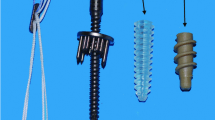Abstract
Posterior tibial translation (PTT) of the posterior cruciate ligament (PCL) reconstructed-knee under cyclic loading of 1,000 cycles with a 100-N load was compared between four different procedures, including two reconstructions with patellar tendon graft (transtunnel and inlay techniques) and two reconstructions with hamstring tendon graft (Endobutton and EndoPearl techniques) in twelve fresh-frozen human knees. The EndoPearl technique is a direct tendon fixation using biodegradable interference screws and an anchoring device, while the Endobutton technique is an indirect tendon fixation using a titanium button and surgical tape. The change of PTT after cyclic loading in the Endobutton technique was significantly greater than in the other reconstruction technique. No graft rupture at the killer turn or complete pullout from the bone tunnel was found. The advantage of the inlay technique compared to the transtunnel technique with respect to the posterior stability could not be shown in the current study. Posterior laxity of PCL reconstructed-knees with hamstring tendon graft using the Endobutton technique increased more easily than that with patellar tendon graft. For PCL reconstruction using the hamstring tendon graft, anatomical fixation may be preferable to prevent excessive posterior laxity in the early phase of the rehabilitation protocol.







Similar content being viewed by others
References
Berg EE (1995) Posterior cruciate ligament tibial inlay reconstruction. Arthroscopy 11:69–76
Bergfeld JA, McAllister DR, Parker RD et al (2001) A biomechanical comparison of posterior cruciate ligament reconstruction techniques. Am J Sports Med 29:129–136
Blickenstaff K, Grana W, Egle D (1997) Analysis of a semitendinosus autograft in a rabbit model. Am J Sports Med 25:554–559
Dejour H, Walch G, Peyrot J et al (1988) The natural history of rupture of the posterior cruciate ligament. Fr J Orthop Surg 2:112–120
Fujie H, Mabuchi K, Woo SL-Y et al (1993) The use of robotics technology to study human joint kinematics: A new methodology. J Biomech Eng 115:211–217
Grana WA, Egle DM, Mahnken R et al (1994) An analysis of autograft fixation after anterior cruciate ligament reconstruction in a rabbit model. Am J Sports Med 22:344–351
Harner CD, Janaushek MA, Kanamori A et al (2000) Biomechanical analysis of a double-bundle posterior cruciate ligament reconstruction. Am J Sports Med 28:144–151
Höher J, Scheffler SU, Withrow JD et al (2000) Mechanical behavior of two hamstring graft constructs for reconstruction of the anterior cruciate ligament. J Orthop Res 18:456–461
Höher J, Livesay GA, Ma CB et al (1999) Hamstring graft motion in the femoral bone tunnel when using titanium button / polyester tape fixation. Knee Surg Sports Traumatol Arthrosc 7:215–219
Ishibashi Y, Rudy TW, Livesay GA et al (1997) The effect of anterior cruciate ligament graft fixation site at the tibia on knee stability: Evaluation using a robotic testing system. Arthroscopy 13:177–182
Jakob RP, Rüegsegger M (1993) Therapy of posterior and posterolateral knee instability [in German]. Orthopade 22:405–413
Kitamura N, Yasuda K, Yamanaka M et al (2003) Biomechanical comparisons of three posterior cruciate ligament reconstruction procedures with load-controlled and displacement-controlled cyclic test. Am J Sports Med 31:907–914
Magen HE, Howell SM,Hull ML (1999) Structural properties of six tibial fixation methods for anterior cruciate ligament soft tissue grafts. Am J Sports Med 27:35–43
Margheritini F, Mauro CS, Rihn JA, et al (2003) Biomechanical comparison of tibial inlay versus transtibial techniques for posterior cruciate ligament reconstruction. Analysis of knee kinematics and graft in situ forces. Am J Sports Med 31:587–593
Markolf KL, Zemanovic JR, McAllister DR (2002) Cyclic loading of posterior cruciate ligament replacements fixed with tibial tunnel and tibial inlay methods. J Bone Joint Surg Am 84:518–524
McAllister DR, Markolf KL, Oakes DA, et al (2002) A biomechanical comparison of tibial inlay and tibial tunnel posterior cruciate ligament reconstruction techniques. Graft pretension and knee laxity. Am J Sports Med 30:312–317
Race A, Amis AA (1998) PCL reconstruction. In vitro biomechanical comparison of “isometric” versus single and double-bundled “anatomic” grafts. J Bone Joint Surg Br 80:173–179
Race A, Amis AA (1996) Loading of the two bundles of the posterior cruciate ligament: an analysis of bundle function in A–P drawer. J Biomechanics 29:873–879
Rodeo SA, Arnoczky SP, Torzilli PA et al (1993) Tendon-healing in a bone tunnel. A biomechanical and histological study in the dog. J Bone Joint Surg Am 75:1795–1803
Rosenberg T, Franklin J, Baldwin G et al (1992) Extensor mechanism function after patellar tendon graft harvest for anterior cruciate ligament reconstruction. Am J Sports Med 20:519–525
Scheffler SU, Südkamp NP, Göckenjan A (2002) Biomechanical comparison of hamstring and patellar tendon graft anterior cruciate ligament reconstruction techniques: the impact of fixation level and fixation method under cyclic loading. Arthroscopy 18:304–315
Steiner ME, Hecker AT, Brown CHJ et al (1994) Anterior cruciate ligament graft fixation. Comparison of hamstring and patellar tendon grafts. Am J Sports Med 22:240–246
Tsuda E, Fukuda Y, Loh JC et al (2002) Effect of soft-tissue graft fixation in anterior cruciate ligament reconstruction on graft-tunnel motion under anterior tibial loading. Arthroscopy 18:960–967
Weiler A, Richter M, Schmidmaier G, et al (2001) The EndoPearl device increasees fixation strength and eliminates construct slippage of hamstring tendon grafts with interference screw fixation. Arthroscopy 17:353–359
Woo SL-Y, Hollis JM, Adams DJ et al (1991) Tensile properties of the human femur-anterior cruciate ligament-tibia complex. The effects of specimen age and orientation. Am J Sports Med 19:217–225
Woo SL-Y, Orlando CA, Camp JF et al (1986) Effects of postmortem storage by freezing on ligament tensile behavior. J Biomech 19:399–404
Acknowledgements
The authors would like to thank Dr. Hideki Satoh for the data analysis, and Mr. Seizo Makanae and Mr. Yukihito Sato for their technical assistance. No author or related institution has received any financial benefit from research in this study.
Author information
Authors and Affiliations
Corresponding author
Rights and permissions
About this article
Cite this article
Hiraga, Y., Ishibashi, Y., Tsuda, E. et al. Biomechanical comparison of posterior cruciate ligament reconstruction techniques using cyclic loading tests. Knee Surg Sports Traumatol Arthrosc 14, 13–19 (2006). https://doi.org/10.1007/s00167-005-0633-x
Received:
Accepted:
Published:
Issue Date:
DOI: https://doi.org/10.1007/s00167-005-0633-x




